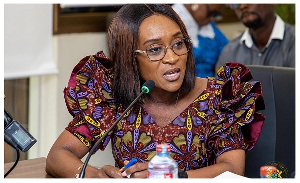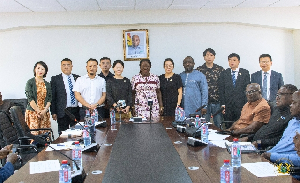Kojo Appiah-Kubi, Phd
A few weeks ago Ghanaians woke up to the good news that the 2011 World Food Prize has been awarded to the former President J.A. Kufuor, together with the former Brazilian President L.I. Lula da Silva. The award was in recognition of “...their independent, personal commitment and visionary leadership in creating and implementing policies targeting the alleviation of hunger and poverty in their countries”. This piece takes a close look at the agricultural performance of President Kufuor’s administration during the eight year term of office and provides a basis as to what might have informed The World Food Prize Foundation to offer him that prestigious award.
Indeed when President Kufuor came into office in 2001 Ghana faced difficult policy choices emanating from the unfavourable economic policy environment and its negative impact on human development. The economy in 2000 was characterised by deteriorating GDP growth (3.7%), large fiscal deficits (8.5% of GDP), a heavy debt overhang (171% of GDP), very low level of international reserves for import cover (2 weeks), rapid deterioration of the cedi (49.8% (dollar)), high inflation rate (40.5%), very high interest rate (47%) and weak state institutions; a combination of which placed severe limitations on the nation’s capacity to address the high incidence of poverty (40%). The economic deterioration was nowhere else so manifest than the agricultural sector, the country’s most important economic sector, employing more than 55% of the country’s labour force, accounting for three quarters of its export earnings and 35% of its GDP. It also contributed to insuring food security, provided raw materials for local industries, generated foreign exchange, as well as provided employment and incomes for most of the population, and thereby contributed immensely to poverty reduction. Agricultural growth rate, for instance, had then declined successively from 5.1% in 1998, 3.9% in 1999 to 2.1% in 2000. In 2000 alone agricultural exports declined by 15%, whilst its contribution to total government revenue fell successively from 12.6% in 1998 to 6.9% in 1999 and further to 3.7% in 2000.
Recognising the importance of agriculture to the economy of Ghana, particularly, as a powerful driver of growth, employment, food security and poverty reduction, the Kufuor regime prioritised the agriculture sector. It did this through modernization strategies based on rural transformation, land reform, increased irrigation, increased mechanization, increased use of improved technologies, value addition to traditional crops such as cocoa, expanding cash crop production and strengthening support to the private sector. These strategies were embodied in several agricultural policy frameworks, strategic plans and programmes such as The Accelerated Agricultural Growth and Development Strategy (AAGDS, 2001), Food and Agriculture Sector Development Policy (FASDEP I & II), National Aquaculture Development Plan, CAADP, etc., which were mainstreamed into the National Medium Term Development Frameworks (GPRS I & II), to accelerate agriculture growth and development. The government also offered subsidies on agricultural inputs such as fertilizers and embarked upon free mass spraying exercises to boost cocoa production. On account of that the ratio of fertilizer use to arable land, for example, increased from 2.5 to 7.5 during 2000-2002 and 2005-2007. It also facilitated credit to the sector, even though agriculture’s relative share of domestic credit increased but stagnated throughout the second term of Kufuor’s regime.
These efforts indeed impacted positively on the agricultural indicators of the country. Consequently the annual average rate of agricultural growth, for instance, jumped, from 3.4% over 1992-2000 to 5.1% over the period of 2001-2008. The rapid agricultural growth is said to be the result of a combination of increased factor expansion and agricultural productivity. It is even estimated that a large proportion of the overall total factor productivity (TFP) growth, particularly, between 2001 and 2005 was a result of agricultural TFP growth. Land under cereal production, for example, grew by almost 10% between 2000 and 2008, whilst cereal yield per hectare rose by about 22% during the same period, compared with a decline in yield per hectare over the 8 year period before. The expansion of lands under cultivation and yield helped to raise production of major staples including cassava, yams, cocoyam and plantains from 15,027,000 MT in 2000 to 21,272,400 in 2008, an increase equivalent to about 42%. Production of cereals such as millet, sorghum, maize, and rice also experienced sharp increases from 1,605,300 in 2001 to 2,296,800 in 2008. This increase is equivalent to about 37%, as compared to only 1.9% between 1993 and 2000. Similarly fish and livestock production also experienced upward improvements with the livestock production index ((1999-2001=100) rising from 102 in 2000 to 127 in 2008. Comparatively the livestock production index during the previous 8 year rule of Kufuor’s predecessor increased only from an index of 90 in 1992 to 102 in 2000. In the light of that food security witnessed tremendous improvements as underscored by the rapid rise in the food production index (1999-2001=100) to peak at 145 in 2008, after growing slowly from a relatively low index of 85 in 1996 to about 99 in 2000. Agricultural production equally experienced some diversification under the Kufuor administration, with 40 percent of growth contribution from non-major crop or livestock productions and introduction of other exportable cash crops under the special programme dubbed Presidential Special Initiative on Cashew, Mango, Oil Palm, etc. A potent indicator of Kufuor’s agricultural success is also underscored by the dramatic improvement in Ghana's cocoa industry that might have been the key to winning him the World Food Prize. Through a combination of right policies including subsidies, specific productivity enhancing measures and other incentives such as the gradual increases in the cocoa producer price, the Kufuor’s government managed to revamp the cocoa sector by doubling production from 340,563 tonnes to more than 740,000 tonnes during its first five years in office.
All these positive gains contributed tremendously to improve agricultural export earnings, food security and poverty reduction. Available data indicates that the share of crops and livestock exports in total merchandise value, for instance, increased from 28.7% in 2000-2002 to 38.1% in 2005-2007. In terms of ensuring food security Kufuor’s success included helping to achieve the Millennium Declaration Goal (MDG) on hunger and to reduce the population of Ghanaians suffering from chronic hunger by more half of the total population ahead of the scheduled 2015 date from 37% in 1992 to 18% in 2008. These achievements are also underscored by improvements in almost all the other basic indicators and traditional proxies for food security including dietary protein consumption (52 to 59 g/person/day between 195-97 and 2005-7); dietary fat consumption (35 to 48 g/person/day between 195-97 and 2005-7) and dietary energy consumption (2480 to 2850 kcal/person/day between 195-97 and 2005-7). All these and other measures contributed to bring down the prevalence of food deprivation, as reflected in the decline in both the number and proportion of undernourished people. Available records reveal that between 1999 and 2007 the number and proportion of undernourished population reduced from 2.2 million and 12% to 1.2 million and 5% respectively, whilst the prevalence of malnutrition among children under 5 years as reflected in wasting, height and weight for age declined from 9.9%, 31.3% and 20.3% to 8.7%, 28.6% and 14.3% respectively between 1999 and 2008. Another achievement worth mentioning is the positive impact of Kufuor’s good agricultural policies and their impact on poverty incidence in Ghana. Available statistics indicate that poverty levels reduced from 40% in 1999 to less than 26% in 2008, a success that made Ghana the only African country to have achieved the MDG one of halving poverty levels in the country ahead of the target date of 2015. Indeed what makes these achievements extraordinary is that they were achieved during the difficult times of a serious global financial meltdown coupled with rising high food and energy prices, as well as other external shocks, whose repercussions caused serious social unrests in many other countries but passed by Ghana unnoticed.
In retrospect the Kufuor administration can be said to have secured significant breakthroughs in the agricultural sector in ensuring food security and poverty reduction, a legacy that needs to be sustained and improved upon by subsequent succeeding governments. There is no doubt that the medium term national goal of attaining an upper middle income status in the foreseeable future within a decentralized and democratic environment requires the agricultural sector to lead the process. Ample available evidence, including the recognition by the World Food Prize, shows that the Kufuor’s administration has laid a solid foundation and a road map towards achieving this goal. Posterity would therefore not forgive subsequent leaders should they fail the nation in this quest.
Opinions of Sunday, 7 August 2011
Columnist: Appiah-Kubi, Kojo














